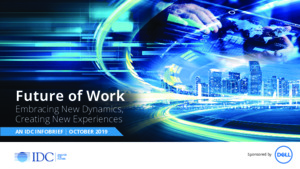This IDC InfoBrief, sponsored by Dell, presents key findings from a global survey that examines the future of work (FOW) trends and their impact on monitors. The survey included over 300 IT and business decision makers, as well as more than 1,200 employees who use monitors for work across the US, the UK and China markets. The findings present stark differences in opinion of both decision makers and employees around expectations of their work, health and safety; as well as their motivations at work and technology priorities. In many cases, we observed huge variance in the voice of employees versus the decision makers or executives on topics such as device choice, desired features, and factors that impact employee motivation.
This report also examines how the growing adoption of new technologies such as artificial intelligence (AI), augmented/virtual reality (AR/VR) and 3D computing are creating new workloads and demanding better monitors and visualization technologies. In addition, the workforce is increasingly diverse with the expectations of younger generations around mobility, ergonomics, aesthetics and designs being significantly different from the expectations of employers. IT decision makers and line-of-business (LOB) heads recognize that advanced monitors are critical today for supporting a wide variety of emerging data-centric, content and design tasks, as well as for improving productivity. However, the survey also points to the fact that monitors are often not seen as part of the FOW or broader digital transformation initiatives. In fact, more than one-third of IT and business decision makers surveyed replace their monitor only when it breaks or when they relocate; while employees have expressed concerns about productivity loss due to connectivity issues, health issues due to poor ergonomics and other factors that impact their experience negatively.
In order to meet the FOW demands, IT and business decision makers need to redesign their monitor policies by moving away from their one-size-fits-all strategy and adopting a persona-based computing approach. By offering employees more choices, empowering them with the latest technologies and adopting new policies to suit the needs of younger generations, it will not only improve employee productivity but also help organizations attract and retain the best talent.


